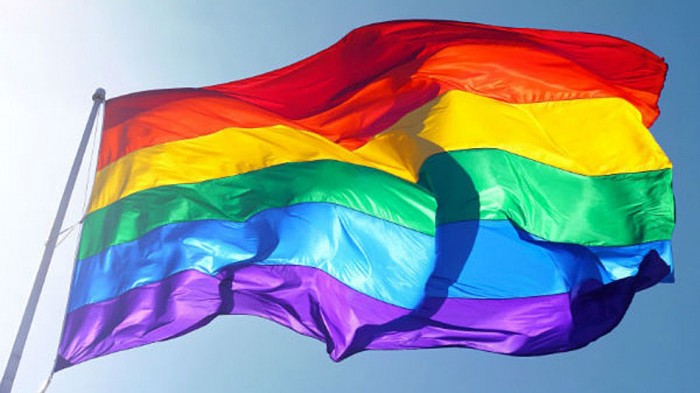The Pride of the Smithsonian
The Smithsonian has a long history of diversity–in our collections, in our exhibitions and in our staff. As Pride month draws to a close, Max Kibblewhite takes a look at how the Smithsonian is preserving and promoting the stories of the LGBTQ community.
Franklin Robinson Jr. spent Sunday, June 12, fulfilling an annual tradition: collecting pamphlets, posters, flyers and other ephemera from the participants and vendors at Washington, D.C.’s 41st Pride Festival dedicated to celebrating lesbian, gay, bisexual and transgender individuals. Robinson, an archives specialist with the National Museum of American History, has been accessioning papers related to the LGBT American experience for close to a decade now.
“I take my little market bag and I go from table to table and I scan the materials and handouts and collect one of each,” Robinson says.” The item has to relate to the LGBT community and how that community is being addressed. Does the item sell, teach or inform? Is the community portrayed positively or negatively? That’s the purpose of collecting and continuing to collect these materials over time. ”
The National Museum of American History’s archive and collection of LGBT artifacts spans over 100 cubic feet and a century of history, from early persecution and discrimination and the events at the Stonewall Inn in 1969, through the AIDS crisis of the 1980s to last year’s Supreme Court ruling on marriage equality.
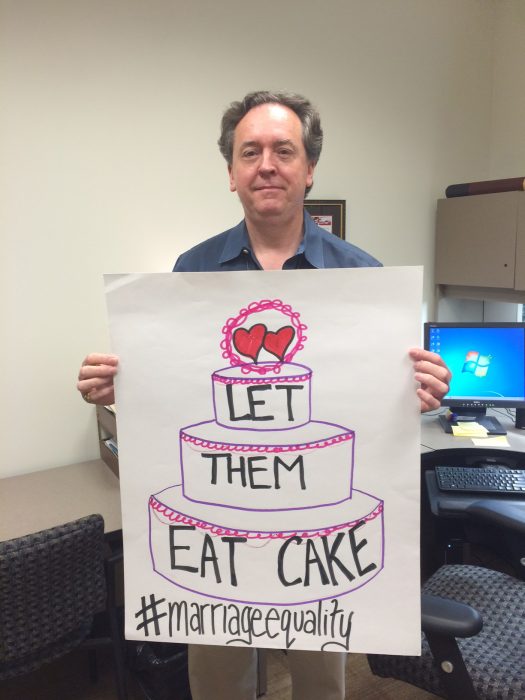
Frank Robinson with a poster he collected for the National Museum of American History collection from a member of the crowd awaiting the 2015 Obergefell v Hodges Supreme Court decision on marriage equality. (Photo by Max Kibblewhite)
Robinson and others from the Smithsonian Institution have mingled with the crowds outside the Supreme Court many times awaiting decisions, including the historic Obergefell v. Hodges ruling in 2015 that established the equality of same-sex marriages nationally. “I grabbed a handful of business cards,” Robinson says, “and if I saw an interesting poster, I just went up to that person and said ‘I collect for the National Museum of American History’s Archives Center and I really like your poster! I’d be happy to take it now or you’re welcome to drop by or mail it to me and it will become a part of the Smithsonian’s national collections.”
The collection focuses on objects related to the LGBT experience, for better or worse. Robinson calls attention to a striking item in the archive: a booking card for a man arrested for sodomy in 1915.
“We have to strike a balance so that future researchers can understand the struggle,” Robinson says. Homosexual behavior was illegal and sodomy laws outlawing “unnatural” sexual behavior remained on the books in many states well into the 21st century until the historic Lawrence v. Texas Supreme Court ruling of 2003.
“People are often surprised that you could be arrested for being gay,” Robinson continues. “This card is very poignant in a way because it shows the man’s mugshot and tells exactly where and why he was arrested. There’s no question as to what this is about. They sent him to jail because one evening he was caught trying to find someone like himself with whom to make a simple human connection—a connection that was absolutely forbidden to him.”
A century after Mr. Mooney went to jail, law enforcement officers walk in Pride parades and host booths at the same Pride festivals Robinson visits. “Our culture has changed in the United States,” he says. “There’s still more to be do, of course, but the fact the FBI, the CIA and the DEA are actively recruiting from the LGBT community says a lot about how far we’ve come.”
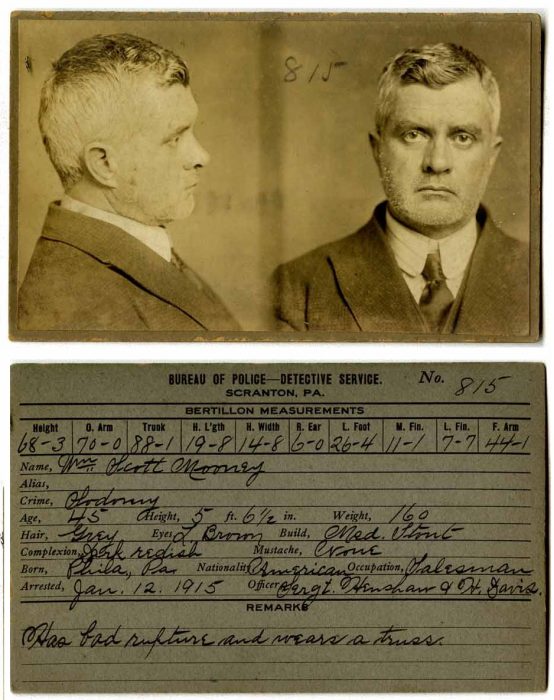
A booking card for Scott Mooney, arrested for sodomy by the Scranton, Pa., police in 1915. (Courtesy National Museum of American History)
The Smithsonian has a long history of promoting and protecting diversity through its collections, exhibitions and especially, among its staff. Leonard “Len” Hirsch, a former Smithsonian employee, was instrumental in creating Federal GLOBE (Gay, Lesbian, Bisexual, and Transgender Employees) in 1988 to advocate for LGBT government employees. His legacy lives on in the group SI GLOBE, co-chaired by Ranald Woodaman, Exhibits and Public Programs Director of the Smithsonian Latino Center; Todd Doane of the Office of the Chief Information Officer; and Katherine Ott, curator with the National Museum of American History.
Ranald Woodaman has this to say: “[The Smithsonian is] moving towards a more inclusive, equitable, pluralistic, representation of the American and global experience. And that’s taken a really long time and has had a lot of ups and downs. It’s not just us, but it’s part of the times. It’s really about relevance and talking about issues that, for the Smithsonian old guard, might be uncomfortable, but are increasingly everyday part of American conversations.”
In fact, the Smithsonian “old guard,” as represented by the Office of the Secretary, has stepped up and proudly taken its place in support of the LGBT community. In 2015, the Smithsonian was officially represented in the Washington, D.C., Pride Parade by members of SI Globe and senior staff, including then-Acting Secretary Al Horvath.
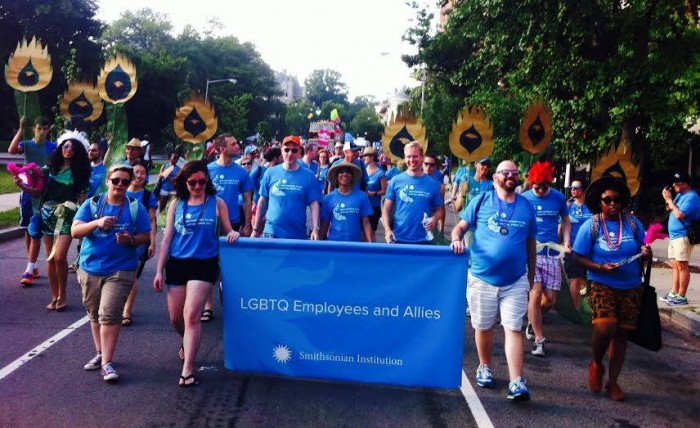
For the first time, the Smithsonian’s lesbian, gay, bisexual, transgender and questioning/queer employees were formally represented at the annual Capital Pride Parade in June. Joining the “fighting peacocks” of SI Globe and friends in the parade were Acting Secretary Al Horvath; Eduardo Diaz, director of the Smithsonian Latino Center; Johnnetta Cole,director of the African Art Museum and Cynthia Brandt Stover, director of the National Campaign. (Photo courtesy of Rogelio Plasencia)
Woodaman also has a large role in creating events and venues that demonstrate the Smithsonian’s commitment to diversity, including several Pride-related film festivals and discussion panels.
The Latino Center recently presented “Recovering Latinx LGBT History,” hosted by activist Dan Guerrero. The program, organized by Woodaman and sponsored by the Human Rights Campaign, is part of an ongoing effort to elevate the voices of LGBT minorities both in history and contemporary times. Woodaman explains, “The LGBT and Latinx (a term used by the Latino LGBT community to signify gender inclusivity) communities have long been intertwined.
“The optics of the feminist movement and the gay movement have really been represented as white movements. Even events like Stonewall have been whitewashed in their representations. But we know many of the people at the forefront of these battles were street kids, trans[gender] kids, a lot of people without a lot to lose. We’re trying to highlight the presence of Latinos in gay activism since the very beginning. The more you get into it the deeper and more complex the story becomes. What we’re trying to do is highlight Latinos and Latinas as historical agents, not just passive people on the sidelines.”
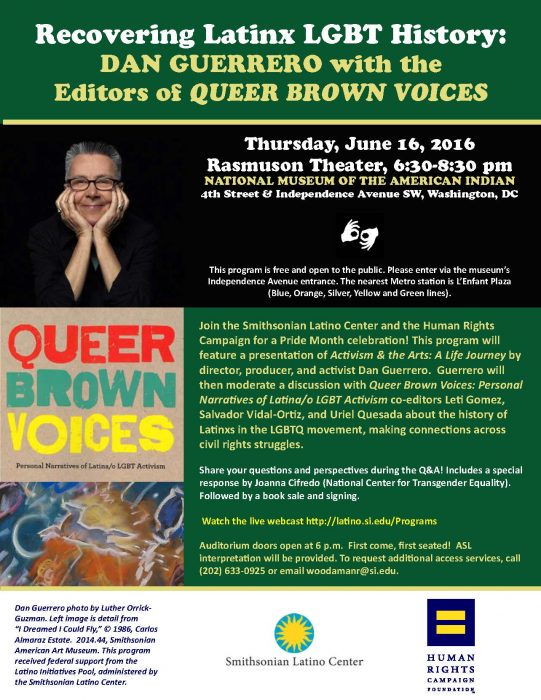
The poster for “Recovering Latinx LGBT History,” hosted by activist Dan Guerrero. The event was organized by the Smithsonian Latino Center.
SI GLOBE also hosts its own Pride Mixer for SI staff and friends to meet, mingle and celebrate. This year’s mixer, held on a warm June evening at the roof garden of the Smithsonian’s Capital Gallery space in Washington, brought together staff and interns of different ages, sexualities, genders and races from across the Smithsonian.
For many, the mixer was a time and place of healing after the murderous attack on the LGBT nightclub Pulse in Orlando the morning of June 12. Despite the somber week of mourning preceding the June 17 gathering, there was a sense of serenity, a sense of community, a sense of “Capital-P Pride.” As Frank Robinson says, “Once you meet somebody different and realize that they’re not a monster, only the hardest-hearted person can maintain the opinion that this person isn’t deserving of civil rights or respect. If you can know the unknown, it’s not so scary, it’s not so threatening, it’s no so fearful.”
Doane and Ott encouraged the feeling of solidarity, embracing each other and reminding those gathered for the Smithsonian’s celebration of Pride that gay lives are still there, that we will keep fighting and we will keep celebrating.

Secretary Skorton addresses the crowd at the SI GLOBE mixer held June 17, 2016. (Photo by Max Kibblewhite)
Secretary David Skorton took some time to reflect on the events of the previous week, sharing his thoughts and prayers with the LGBT community and reminding the gathering of the Smithsonian’s responsibility to exemplify the standards of diversity and inclusivity by being a model of what a diverse national cultural institution should be.
The events of June 2016 will soon become history–accessioned into the LGBT collection at NMAH and cataloged accordingly, adding to the ever growing narrative about American life. When asked why LGBT history matters in the American tale, Robinson smiles. “It is all history and it is all American history. We are the primary sources for those who will come after us.”

OCEA intern Max Kibblewhite takes a selfie at the SI Globe Mixer with (from left) Shawnie McRaney of the National Postal Museum, Jenna Jones from Smithsonian Associates and guest Stevie Gagnon. (Photo by Max Kibblewhite)
Posted: 30 June 2016
